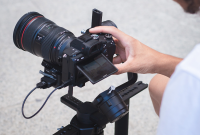Find Out How to Get a Good Deal on a Digital Camera at a Low Price
On eBay, there is a healthy and fluid market for digital cameras, both new and second-hand (aftermarket). Over the last several years, there has been a significant increase in the use of digital cameras. The use of obsolete film and development has been limited nearly entirely to the archives thanks to technological advancements. Quality cameras are available at a range of prices, ranging from well under $500 to well over $2,000. Professionals, amateur enthusiasts, and ordinary homes all seem to be purchasing cameras, with many households owning more than one camera. The issue then arises: how can I get a digital camera at the lowest feasible cost?
A high volume of most models is exchanged on a daily basis, making it the most efficient market in the world. It is possible to analyze the behavior of this micro-market and come up with some effective purchasing guidelines. With a little bit more knowledge than the rest of the market, it is practically likely that one may make some wise purchasing decisions. The goal of this post is to explain how to find these gaps and how to frequently acquire digital cameras for 20 – 40% less than retail price.
This essay should be read in conjunction with my larger post as well as a website that provides the information necessary to select nuggets for purchasing purposes. The links and URLs to these two websites may be found at the end of this article. The digital camera market is the exclusive subject of this specialized website, which is dedicated solely to it.
The majority of the material available on eBay is geared towards the selling aspect, namely how to sell your items. I’ve tended to focus on the purchasing end of the business, looking for market possibilities and pricing inefficiencies in order to truly catch fantastic bargains when they come along. In order to do this, we must first comprehend the mechanics of the eBay market environment. It is driven by supply and demand, just like any other market, and much like a major flea market, if a buyer has information about how many goods are for sale at what prices and how many other buyers are in the market, that buyer might have an advantage over the rest of the market. Let’s put a bit more emphasis on supply.
The supply dynamic on eBay is a bit different in that the availability of an item must be determined at a certain moment in time. To put it another way, since auctions conclude at various times, it is necessary to keep track of the number of auctions that end in close proximity to one another for the same item. This allows you to get a sense of the availability of things, or in our instance, cameras. What makes this intriguing is that there may be a large number of auctions finishing today for a given model, but there could be relatively few auctions ending next week for the same model. This is one of the factors influencing the pricing.
The demand side is a little more complicated and difficult to understand for the ordinary eBay customer. This is when the information on the website I mentioned at the bottom of this page comes in handy. Demand on eBay is assessed (by sellers) by a variety of criteria, including the number of people who see my auction, the number of people who ask questions, the number of people who put me on their watch page, and the number of people who actually bid. Obviously, as we go down the list, the data becomes more credible as a predictor of future demand for the product. Page views are difficult to come by, despite the fact that some sellers include a counter on their auction sites that is visible to the public. Sellers will have access to questions and watchers, and the information will be made public via the specific web site indicated below. The total number of bids is accessible for everyone to see.
If we were to create a graph showing the changes in the number of questions, viewers, and bids as the auction goes on, we would be able to observe how the demand varies as time advances. Typically, if the number of queries and viewers is large but the number of bids is low, this indicates that there is some uncertainty and a potential purchase opportunity. If the number of observers is very high and growing but the number of offers is minimal, this might indicate a last-minute bidding battle and serve as a stay out indication.
Armed with this knowledge, as well as a brief overview of other comparable auctions that are about to conclude, as well as a rapid sense of the skill set of the seller and the current top bidder, one may see a picture that is significantly different from that of the typical eBay purchaser. Soon, the trained eye will be able to see some excellent purchasing possibilities. For the professional or hobbyist photographer, this will result in a number of digital camera purchases that are far less expensive than retail prices in the near future. A lot of people buy diamonds at a discount of 20 – 40 percent off the retail price, for example. Let’s face it, most digital cameras continue to function flawlessly years after they were purchased. In contrast to analog electronics, digital electronics do not deteriorate with time, making aftermarket sources like eBay an excellent location to purchase cameras at a low cost.



